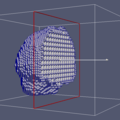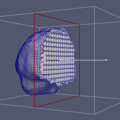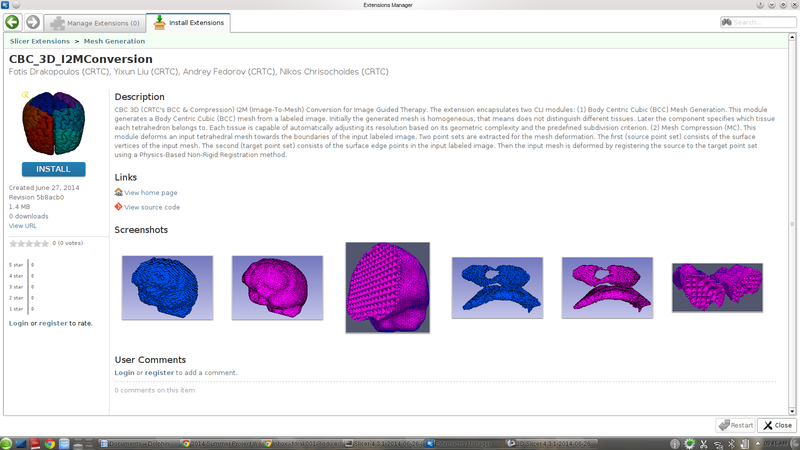2014 Summer Project Week:CBC 3D I2MConversion
Key Investigators
- Fotis Drakopoulos (CRTC)
- Yixun Liu (CRTC)
- Andrey Fedorov (BWH/SPL)
- Ron Kikinis (BWH/SPL)
- Nikos Chrisochoides (CRTC)
Project Description
The CBC_3D_I2MConversion project generates a tetrahedral mesh from an input labeled image. The method consists of two modules:
- Body Centric Cubic (BCC) Mesh Generation
This module generates a Body Centric Cubic (BCC) mesh from a labeled image. Initially the generated mesh is homogeneous, that means does not distinguish different tissues. Later the module specifies which tissue each tetrahedron belongs to. Each tissue is capable of automatically adjusting its resolution based on its geometric complexity and the predefined subdivision criterion.
- Mesh Compression (MC)
This module deforms a tetrahedral mesh towards the boundaries of the labeled image. Two point sets are extracted for the mesh deformation. The first (source point set) consists of the exterior surface vertices of the input mesh. The second (target point set) consists of the exterior surface edge points in the input labeled image. Then the input mesh is deformed by registering the source to the target point set using a Physics-Based Non-Rigid Registration method.
Objective
- Develop a mesh generation extension that encapsulates two CLI modules:
- BodyCentricCubic (BCC) mesh
- Mesh Compression (MC)
Approach, Plan
- The current version of the extension supports a single-tissue mesh generation.
- The next versions will support multi-tissue mesh generation.
Progress
- The extension is available in the nightly build version of Slicer with name: CBC_3D_I2MConversion.
- The documentation page for the extension is available here: https://www.slicer.org/wiki/Documentation/Nightly/Extensions/CBC_3D_I2MConversion.
- Three cases (brain, nidus and ventricles) are provided for testing.
References
- Tetrahedral Mesh Generation for Medical Imaging.
Fedorov A., Chrisochoides N., Kikinis R., Warfield S., The Insight Journal - 2005 MICCAI Open-Source Workshop
- Mesh Deformation-based Multi-tissue Mesh Generation for Brain Images.
Yixun Liu, Panagiotis Foteinos, Andrey Chernikov and Nikos Chrisochoides. Engineering with Computers, Volume 28, pages 305-318, 2012.







